The May 2024 edition of Dermatology Times presents a range of insightful articles on skin cancer, innovative treatments, and the latest research in dermatology. Below are the highlights of this issue. To stay updated with Dermatology Times, subscribe to our eNewsletters and receive the free print issue and supplements every month.
The Evolving Complexity of Skin Cancer Care
Fort Myers and Naples, Florida, known for their beautiful coastlines and retirement-friendly atmosphere, have become centers for specialized skin cancer care. Brothers Brian Harris, MD, H. Ross Harris, MD, and Keith Harris, MD, established dedicated clinics to serve the elderly population in these areas. They share their reflections on Melanoma and Skin Cancer Awareness Month and provide clinical insights to enhance patient care.
“It’s quite a personal relationship we have with this type of cancer,” H. Ross Harris told Dermatology Times. “Multiple family members, including our parents and siblings, have experienced skin cancer. Five of us have had cutaneous melanoma. Educating the public about the importance of skin cancer detection and early detection is not just a professional duty for us; it’s deeply personal.”
Effectiveness of Prebiotic Skin Care in Atopic Dermatitis for Skin of Color Patients
A recent study involving 140 patients, half of whom had skin of color, assessed the impact of La Roche-Posay’s Lipikar AP+ Gentle Foaming Cleansing Oil and Lipikar AP+M Moisturizing Cream on mild atopic dermatitis (AD) and severe xerosis. Participants, aged 3 to 80, used the cleanser for two weeks followed by the moisturizer for an additional eight weeks.
Key findings include:
- The prebiotic regimen significantly reduced severe xerosis and mild AD severity, improving skin roughness, appearance, and barrier properties while decreasing itchiness within two weeks.
- Patients of color with AD experienced more severe itching compared to their White counterparts, whereas White patients with xerosis reported a lower quality of life at baseline.
- The use of SkinCam allowed for the capture of high-quality clinical images, demonstrating improvements across different skin tones with the prebiotic regimen.
Dermatophytoma: A Critical Diagnosis
Dermatophytoma, a frequently overlooked subtype of onychomycosis, was first identified by Roberts and Evans in 1998. Characterized by a dense white linear or round area and a thick hyperkeratotic mass easily removed from the nail plate, this condition requires careful attention. Histopathology reveals densely packed dermatophyte hyphae, resembling aspergilloma in its fungal composition. Treatment often necessitates surgical removal of the nail plate, paralleling the approach for lung aspergilloma.
IL-23 Epitope Surface Area and Psoriasis Treatment Efficacy
A study published in JID Innovations explored the structural properties of IL-23-binding epitopes to understand their clinical efficacy in treating plaque psoriasis. Researchers Daniele et al. examined risankizumab, tildrakizumab, and guselkumab (targeting the IL-23 p19 subunit) and ustekinumab (targeting the IL-23 p40 subunit). Conducted in the lab of Christopher Bunick, MD, PhD, at Yale University School of Medicine, the study sought to connect molecular properties to clinical outcomes.
“This study has a significant translational impact by linking science to clinical practice,” Bunick told Dermatology Times. “Having prescribed IL-23 biologics for years, understanding their mechanistic similarities and differences is crucial for optimizing patient care.”
For more details, continue reading the full articles in this month’s issue of Dermatology Times.



























